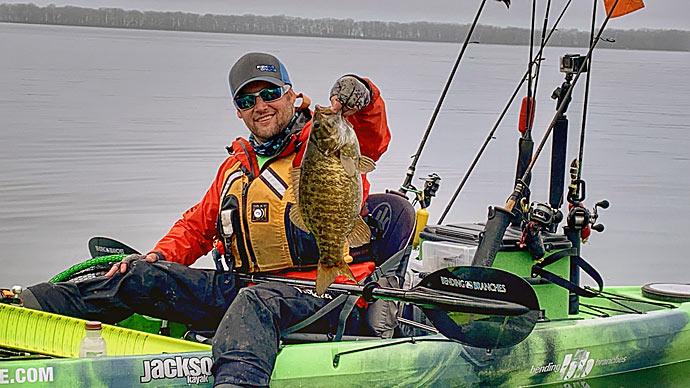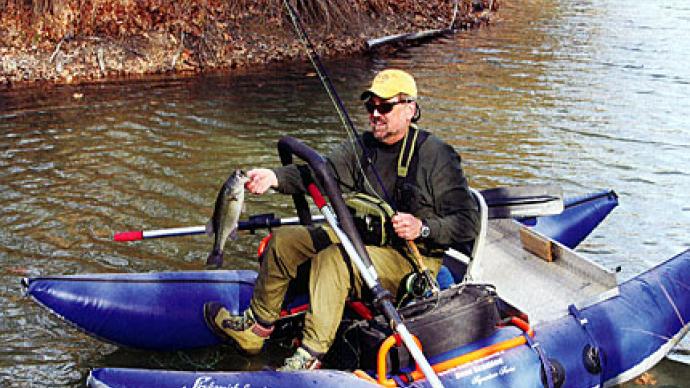The jumble of kayaks in my garage and adjoining shed prevent the storage of things you would normally place in a garage, such as a car. At the time I am writing this, I own ten kayaks. Most of them see use through the kayak fishing Classes I teach on rivers and reservoirs. Some of them are perfect for trips with my two sons, Sawyer and Cooper. Some of them only see the light of day on rare occasion when I fish technical whitewater streams. Some only get wet when I take a rare trip to salt water.
I would not recommend assembling the kind of fleet that chokes my garage. I know others who suffer from the same affliction. The disease pales in comparison to the compulsion to collect soft plastics or fishing rods. But the net result is the same: a fire hazard, and a wife who is upset that she can’t park her vehicle inside a two-car garage the night before a snowstorm. The following description of my fleet should serve to help you avoid this disease by choosing the right kayak for your needs.
Tarpon 100 with thigh straps

This kayak graces the cover of my book In Pursuit of Trophy Smallmouth Bass: My Life in a Kayak. The ten-foot length allows for quick maneuvers while fishing small streams featuring up to Class Three whitewater. I’ve completed a few three-day camping/float trips out of this kayak, but would only do so again if the water to be fished required great maneuverability. This small kayak gets the nod when I have to bushwhack a great distance to get to the water.
Strengths: Ease of transport, maneuverability, good starter kayak for a kid.
Limitations: Gear and weight capacity, speed on flat water.
Ideal Application: Streams and rivers with plenty of Class Two and Three whitewater. Thigh straps are a must for this application.
Tarpon 120 Angler with rudder
Wilderness Systems sells more of these sit-on-tops than any other for a reason. This twelve-foot model provides an ideal balance of maneuverability and speed for most freshwater anglers. Still able to handle Class Ons and Two whitewater, it has the ability to move upstream much easier than the Tarpon 100. Add the angler package with rudder, and you’ve got a perfect fishing kayak for anglers who fish both rivers and reservoirs. This model is what I put most of my kayak-fishing students in.
Strengths: A good blend of speed and maneuverability, greater carrying capacity.
Limitations: Too slow for covering great distances of flat water.
Ideal Application: A mixture of river and reservoir fishing.
Tarpon 120 Ultralight
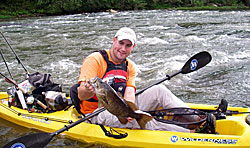
I initially thought that this would be a perfect first kayak for my son Sawyer. Weighing only forty-two pounds, I reasoned that it should provide an easy entry into paddling his own kayak instead of sitting in my lap. My good intentions didn’t last long. I wanted to paddle it myself.
On the Susquehanna at an area with Class Three rapids called the Dauphin Narrows, I paddled upstream through the entire system of ledges without needing to hop out and drag over the rocks. I tested the agility of the lightweight craft, and found that it was easier to maneuver than my Tarpon 100, a boat that is two feet shorter.
I had my reservations on if it would stand up to the kind of abuse I would subject it to. I actually meant to break the thing. I overloaded it with things like a live-well cooler full of water and live smallmouth, took the roughest routes through rapids, dragged it mercilessly over ledge rocks, across parking lots, and down steep rocky embankments. I let snow fall on it, melt, freeze, and hit it with a pipe wrench to knock the ice loose so I could take it fishing again. I am sure that I could actually break it if I did something outside of abuse in the name of haste to go fishing, but the same things would injure a plastic kayak much sooner.
By the time I had my first Tarpon 120 Ultralight a full year, I had three of them. The boat could just as easily be named the Tarpon 120 Ultradurable. The price tag commands what you would expect for a boat that will last quite a bit longer than a standard kayak. I would be surprised if this material didn’t put plastic boats out of the market. It probably won’t happen fast, as price point is the buyers first concern, but it will happen.
Strengths: Ease of transport, good blend of speed and maneuverability. Car-topping without shoulder injury.
Limitations: Price.
Ideal Application: Whitewater kayak fishing. Flat-water kayak fishing in small to medium lakes (A Tarpon 140 or 160 is faster for covering large expanses of water).
Commander 120
This hybrid provides a unique perspective. The hull design allows an angler to fish or paddle from three distinct positions: seated in main seat, slightly elevated in the captain’s perch (my favorite) or standing up. At twelve feet long, this is Wilderness Systems most agile sight fishing boat.
Strengths: Sight fishing, agility, lightweight
Limitations: It’s not self-bailing like a sit-on-top kayak. Speed.
Ideal Application: Small to medium sized lakes, rivers without Class Two or above rapids.
Commander 140
Similar to the Commander 120, but faster and more stable, this kayak is a sight fisher’s dream. I usually stick with shorter kayaks for river trips, but when the flow is low, and I need that extra volume to scoot through the shallows without running aground, I’m in my Commander 140.
Strengths: Sight fishing, speed, gear capacity
Limitations: Agility in whitewater, not self bailing
Ideal Application: Mine was sight fishing a low and clear river, but it’s great for any reservoir or tidal water where you need to stand up and sight fish.
Tarpon 130T
I’m usually not into what those in the business refer to as “divorce boats,” but I have one of them. Tandem, or two person kayaks seem like a good idea, but I stopped paddling a canoe for a reason. The exception was made so I could take both of my sons with me on a longer float trip. A friend who also has two sons and paddles this kayak convinced me that this was a good application. With Sawyer in the back, and Cooper up front where I can keep my eyes on him, this large sit-on-top provides ample room. Seating options include regular seats fore and aft, and a molded in middle seat for how I am using it with two kids on board.
Strengths: Occupancy
Limitations: Not ideal for solo use. Wind can be problematic.
Ideal Application: Up to Class One rapids with multiple occupants. Flat water.
Tarpon 140 Angler with rudder
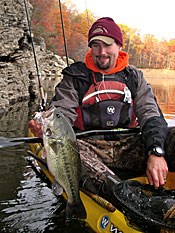
This kayak provides the speed I need to fish the reservoirs with a run and gun approach. Significantly faster than the Ride or Tarpon 120, it allows me to fish the far reaches of some of the largest electric only reservoirs. I’ve had one of the electric powered bass boaters come over and ask “How did you get back here before I did?! My 140’s have rudders as a means to foot steer away from areas I am fishing as my momentum carries me past where I just cast.
Strengths: Speed, weight capacity
Limitations: Maneuverability in moving water.
Ideal Application: Small to medium sized lakes, tidal waters.
Tarpon 160 Angler with rudder
I’ll load the 160 into the back of my pickup when I’m headed to big water. The need to cover vast expanses of water in a hurry is fulfilled with this super fast kayak. Bad weather can pop up quickly on the Chesapeake Bay. Birds converge in a precise spot where a brief window of opportunity exists to catch actively feeding stripers. Both situations require a kayak that can get you there NOW.
Strengths: Speed, weight capacity
Limitations: Maneuverability in moving water.
Ideal Applications: Saltwater, large lakes.
Ride 135 Angler with rudder
Before owning one of these kayaks, I would tell people that if I were able to have only one kayak, the Tarpon 120 would be it. The Ride has taken over that title. Being able to stand up in this kayak to sight fish at great distances has completely changed how I approach and fish an area. I do most of my guiding from this standing position as well. When planning a multiple day float trip, this kayak carries camp. In drought conditions when most kayaks run aground, the Ride scoots through the skinniest water without so much as a scrape. It’s also been an appropriately stable and wide kayak to take when fishing with one of my two sons. At the time I am writing this, an ultra-light version is not available. That is the only step shy of the perfect all around fishing kayak existing. One can only hope, plead, and cajole. Build it Wilderness Systems!
Strengths: Stability/stand up ability, weight capacity, skinny water.
Limitations: Difficult for some to car-top or carry a great distance, maneuverability in heavy whitewater. Not a good starter boat for kids because of its width.
Ideal Applications: Limitless. The best choice for anglers weighing more than 250 lbs.
An OutSTANDING Gimmick
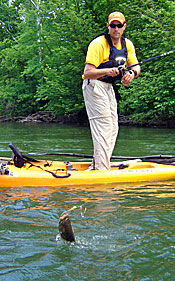
Chad Hoover, a fellow Wilderness Systems Fishing Team member waved to me from a standing position on his kayak in the middle of Wilck´s Lake. I chuckled to myself, “That’s a nice little gimmick to sell kayaks!” We were both there to assist patrons of Appomattox River Company’s annual demo day in Farmville, Virginia. He paddled over (still in the upright position) and invited me to try standing up on one of the demo kayaks. I shook my head with a skeptical grin.
Chad’s peer pressure continued until I decided to play along. The result of an embarrassing dunking seemed inevitable. I tenuously shifted my weight forward to the balls of my feet. The Wilderness Systems Ride 135 wavered briefly. I fought the powerful urge to sit right back down. Within a few minutes, I found myself gliding along in an upright position, palming the rounded tip of my paddle with one hand, and powering a stroke with the other. One of the patrons surged in my direction, obviously out of control. A last minute turn by both of us averted the collision, but the wake thrown my way had me in a crouch position quickly.
Chad paddled over and told me to just relax. “Here, this will teach you to trust that kayak. Flamingo!” he said, showing what he meant by lifting one leg off of the kayak. I had trouble believing what I saw. I slowly shifted my weight onto my left leg, causing that side of the kayak to almost submerge. I chickened out.
Chad smiled and poked more fun at me. A second attempt allowed me to briefly achieve a Karate Kid stance before evenly distributing my weight again. Once the kayak dipped all the way down, it stopped and held me short of tipping as if someone was underwater stabilizing it. It was enough for me to believe. The boat was stable.
I decided to get one that day, as did several people who witnessed the demonstration. One of them called out to Chad from shore, “That’ll work fine until you hook into a big ol´ bucket-mouth!” Never one to stand down from a challenge, Chad leaned down to a kid paddling by in a whitewater kayak. He asked him to play the role of a fish. He cut off a lure from one of his baitcasters and tied his line to the rear handle of the kid’s kayak, asking him to do his best to topple him into the lake. Much thrashing on the part of the “fish,” and some drag pulling on the other end of a very taught line left Chad with a confident “Do you believe me now?” expression on his face.
Sight Fishing
Despite each of these demonstrations, I still believed that fishing in the upright position was a gimmick, not a useful tactic. But as I became more comfortable paddling from a high vantage point, sometimes through rapids, I started to get it. I’ve always been good at drifting through a pool, completely motionless in order to spot big fish cruising. Now, with the higher vantage point, I’ve reached a new level of sight fishing.
Spotting individual fish helps tremendously, but isn’t the main advantage of having such a far reaching radius of structure and cover that you can see. My catch rates in clear low water conditions have soared in large part to being able to spot deep-water structure and cover from a distance. My buzz baits trace the edge of a sandbar drop off. Tubes tickle the trunk of a lay down hat I wouldn’t have seen from a seated position. Polarized glasses help immensely, but nowhere near as much as quadrupling your vision range by standing up.
The question of stability was laid to rest when Chad used the kid in the kayak to prove his point. During my second year standing up, I was forced to test the limits of stability myself. I had been fishing the upper end of a Maryland reservoir for pre-spawn largemouth. I sight fished for them as they moved in and out of a section cut off to bass boats by a line of rip rap that came within inches of the surface.
I spotted a large fish at my maximum casting distance, and gave my weedless-rigged tube a heave. Casting distance also increases with an elevated launching point. As soon as the tube splashed down, the large fish rocketed to the spot, and immediately started to pull drag. The drag’s zing lasted until my kayak fell in line with the finned tug boat. The powerful pull of this huge fish carried me about thirty yards, at which point it launched skyward.
A full set of teeth flashed as an approximately thirty-five inch musky tail-walked, severing my line, and relieving a great deal of line tension that I had been leaning against. I’ve replayed the moment over and over in my mind, and I still do not know how I did not end up in the lake. That was the moment that I decided to test the limits of stability. Since then, I’ve run rapids standing up, stayed upright as wakes from powerboats rocked me back and forth, and stood up to swat lures out of trees with my paddle.
The Point of No Return
As I mentioned earlier, my students are subjected to the drill where the kayak is intentionally flipped to learn the tipping point. With a boat like the Tarpon 120, that point is met, and the boat flips. With the Ride, my student’s butt usually slides off the wet seat, leaving the kayak remaining upright. I’ve successfully flipped them before on purpose, but it always took my pulling it over with me like it was a blanket.
Paddling a sit-on-top kayak instead of a sit-in kayak changed how I kayak fish. An entirely new set of maintaining boat position tricks came about naturally. Fishing from a comfortable side-saddle position became common. Being able to stand up in a kayak brought about the same kind of “changed how I kayak fish” moment in my evolution.
Why no sit-in kayaks?
This question is posed to me more than any other. When I started Blue Ridge Kayak Fishing LLC, my entire fleet consisted of sit-in kayaks with skirts, hand bilge pumps, and car wash sponges to remove any water that found its way into the hull. Therein lies the biggest advantage of sit-on-tops: they are self bailing.
Harry Longerbeam, the regional Wilderness Systems sales rep at the time I started my business, tried explaining this to me for a few years before I considered a sit-on-top. I liked what I was used to. Apparently I enjoyed the periodic need to pull over to shallow water, stop fishing, remove the bulk of the water with a hand bilge pump, and finish it off with a car wash sponge.
Another reason I was resistant to sit-on-tops was that I fished year round. I figured that the bubble of hard plastic surrounding the lower half of my body provided good insulation from cold weather. I was correct, but it wasn’t anything that a good set of fleece pants and Palm bibs couldn’t overcome.
Self-bailing frees up a great deal of time to focus on fishing, but isn’t the only advantage. The freedom my legs had to move to different positions translated to being more comfortable throughout the day. Flopping my legs over the side to cool my feet in the summer quickly became an easy way to “anchor” in shallow water. Taking it one step further in a little deeper water, I could stand up thigh deep, and allow the kayak to come to rest on the backs of my legs as I fished downstream of my fixed position. These maintaining boat position tricks could not be replicated easily with my sit-in kayaks.
One by one, my Pamlicos, Pungos, and white water sit-in kayaks were sold off and replaced with Tarpons of varying lengths. The last one to go was my wife’s kayak, an Old Town Otter, which she liked because it had a nice seat back. Wilderness Systems Phase Three seats took care of that requirement.
In summary, the variety of lengths, widths, and hull designs of sit-on-top kayaks in my garage match the variety of places I fish. Longer skinnier kayaks allow for speedy travel at the expense of maneuverability. They are appropriate for fishing lakes, tidal water, and flat water. Shorter rounder kayaks are slow, but turn on a dime, a feature suited for whitewater fishing. In between, kayaks in the 12 to 13.5 foot range handle a variety of waters well. Wide kayaks allow anglers to fish from the standing position. If I had to whittle down my fleet to one kayak, it would certainly be the Ride 135. Thankfully, I enjoy the luxury of matching the right kayak to the right fishery.
Jeff Little, owner of Blue Ridge Kayak Fishing has his own Youtube channel here: https://www.youtube.com/user/KayakBassFishing



